On 24 July 2023, the fully loaded Achilles Bulker was departing the Port of Tauranga under pilotage when it began unexpectedly swinging to port after clearing the harbour entrance. As the bridge team attempted to correct the course, the ship’s rudder detached, causing it to drift out of the channel into shallow water. The pilots and crew managed to bring the vessel to a stop using both anchors, narrowly avoiding grounding.
Executive summary Tuhinga whakarāpopoto
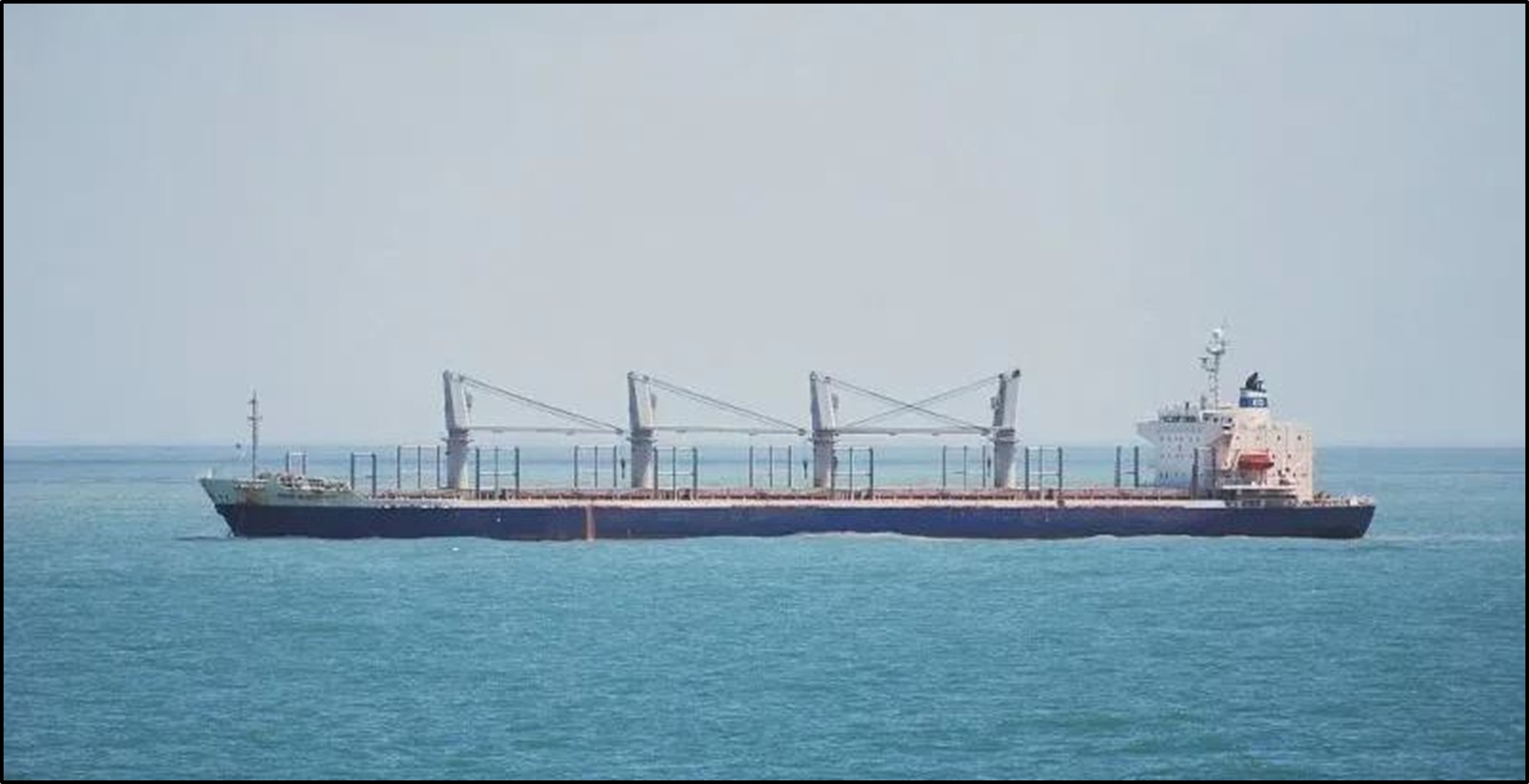

What happened
- On 24 July 2023, the fully loaded Achilles Bulker was under pilotage outbound from the Port of Tauranga. Shortly after clearing the harbour entrance, the ship’s heading began to swing to port and deviate from its intended track in the centre of the channel.
- As the bridge team took corrective action to return the ship to the centreline of the channel, the ship’s rudder broke off and the ship continued out of the channel into shallow waters. The pilots and ship’s crew successfully anchored the ship using both anchors, narrowly avoiding grounding.
Why it happened
- The rudder pintle was missing, which left the bottom of the rudder unsupported and allowed excessive movement in the rudder system. The rudder broke off when the rudder palm fractured on both sides of the rudder stock.
- The pintle dropped out of position and was lost before the ship lost its rudder. As a result, excessive lateral loads had been placed on the rudder palm over time, contributing to the development of fatigue cracks in the palm on both sides of the rudder stock.
- In 2021, Achilles Bulker underwent maintenance during a scheduled dry dock period. During this period the rudder pintle assembly was removed and later reinstalled. It is virtually certain that the way the rudder pintle assembly was reinstalled did not ensure that the pintle would remain in place during normal shipboard operations.
- The way the rudder pintle assembly was reinstalled meant that components used to secure the pintle in place failed, allowing the pintle to drop from the bottom of the rudder.
- The Transport Accident Investigation Commission (the Commission) has identified a safety issue relating to the quality assurance and oversight used during the pintle reinstallation.
- The Commission has made recommendations to address the safety issue.
What we can learn
- Pintles are critical components of a critical system and should be treated as such. The way the rudder pintle assembly is installed is important for the durability of the rudder system and for preventing loss of the pintle and rudder.
- Ship owners and operators have overall responsibility for the ship. It is important that they have sufficient oversight of repairs to components of critical systems to ensure the repair is effective.
- The loss of controlled manoeuvrability of a ship is particularly dangerous when navigating in pilotage waters. Pilots and ship crews need to be prepared for such an event.
Who may benefit
- All ship owners and operators, classification societies, insurance providers, shipyards, pilots, ship crews, maritime education providers and flag state7 regulators may benefit from the findings of this inquiry.
Factual information Pārongo pono
Narrative
- On 24 July 2023, Achilles Bulker had finished loading logs while alongside berth No 10 at the Port of Tauranga. At 1400 (times in this report are in New Zealand Standard Time (Coordinated Universal Time + 12 hours) and are expressed in the 24-hour format) the ship’s crew began pre-departure preparations for their intended voyage to China, testing critical systems (including the ship’s steering).
- By 1454 two pilots had boarded the ship: a qualified pilot and a trainee pilot. The two pilots held a master/pilot exchange with the master to learn about the ship’s characteristics and whether there were any known issues that could influence the conduct of the outbound pilotage. It was agreed between the two pilots and the master that the trainee pilot would have the conduct of the ship (the conn) for the sailing, with support from the qualified pilot. At the time the tide was ebbing and the current in the vicinity of Tanea No.2 and No.4 beacons (Tanea), a critical turning point, was 3.3 knots (kt) and reducing.
- By 1517 the Achilles Bulker was underway with the assistance of two tugs. Once well clear of the berth, the trainee pilot ordered the tugs to take in their lines. One tug was released from duties, while the other continued to follow the ship as an escort tug.
- At 1533 the pilot boat communicated to the pilots that the current at Tanea had reduced to 2.8 kt. By 1540 the Achilles Bulker had begun the turn to starboard around Tanea at a speed of 8.4 kt with the engine half ahead (engine speed set to 50% in a forward direction) (see Figure 3).
- Once abeam of the Tanea No.2 beacon, the escort tug was released. At 1548 the Achilles Bulker had an established track outbound on the No.1 Reach (the final segment of the shipping channel leading to open sea, dredged to 15.8 metres (m)). However, shortly afterwards the ship’s heading began to swing to port. In an attempt to correct the port swing the trainee pilot progressively ordered counter helm until the rudder was hard to starboard. The qualified pilot ordered full ahead on the engine to help arrest the swing.
- By 1549 the port swing had been arrested, with the ship now west of the centreline of the channel. The ship’s heading began slowly swinging to starboard at a rate of 5 degrees per minute (°/min) back towards the centreline of the channel. As a result, the qualified pilot ordered the applied rudder be reduced to starboard 20 (a rudder angle adjusted to 20 degrees to starboard). At about the same time a loud bang was heard throughout the ship and the ship shuddered.

- At 1550 the qualified pilot relieved the trainee pilot of the conn. With the ship’s heading now swinging to starboard towards the centreline of the channel, the qualified pilot ordered port 20 (a rudder angle adjusted to 20 degrees to port) to arrest the swing and regain the centre of the channel. Within seconds of the rudder command a second bang (louder than the first) was heard throughout the ship and again the ship shuddered.
- At a speed of 9.3 kt the ship’s rate of turn had by then reached 36°/min to starboard, so the qualified pilot ordered hard port rudder. By 1552 the qualified pilot had ordered all stop on the engine, ordered that the port anchor be prepared to drop and called the tugs back to the ship. The ship exited the channel at a steep angle into the eastern reserve (an area dredged to 10.4 m immediately east of No.1 Reach) at a speed of 8.1 kt with a rate of turn of 29°/min to starboard.
- The port anchor was dropped with three shackles on deck and the qualified pilot gave the engine order dead slow astern, immediately followed by full astern. By 1553 the ship’s speed had reduced to 6.5 kt and the starboard anchor was dropped with three shackles on deck.
- By 1556 the ship had effectively stopped outside the channel, with approximately 1 m under-keel clearance. Soon afterwards the anchors were retrieved, and escort tugs towed the ship further offshore to the No.1 anchorage.
Personnel information
- The master had held command for three years and had 14 years’ seagoing experience. The master had taken command of the ship in January 2023. This was their first tour sailing aboard Achilles Bulker.
- The qualified pilot had 18 years’ seagoing experience, including six years as an unrestricted pilot. The qualified pilot had joined the Port of Tauranga in 2023 and held a B-class licence (a licence restricted to piloting vessels up to 250 m in length and 12.5 m draft).
- The trainee pilot had 11 years’ seagoing experience and had begun training with the Port of Tauranga in February 2023 as a tug master/trainee pilot. After completing 6 months service on harbour tugs, they had begun pilot training, observing 10 ship movements with a qualified pilot. This was the first time the trainee pilot had been given the opportunity to conn a ship while in the training programme.
Vessel information
- Achilles Bulker was a 177-metre bulk carrier28 built in 2003 by Kanda Shipbuilding in Japan and registered in Panama. The ship was owned by SE Apex Corporation (Taiwan) and operated by Sincere Industrial Corporation’s marine division (Sincere Marine).
Organisational information
- The ship was originally named Irene Oldendorff and had been built for Evermore Marine Corporation (Taiwan).
- In 2009 the name of the ship was changed to APEX Bulker. The ship was later purchased in 2012 by its current registered owner SE Apex Corporation (Taiwan) - leading to the ship’s name being changed to Achilles Bulker. Sincere Marine operated the ship throughout its commercial history.
- SE Apex Corporation was owned by Sesoda Steamship Corporation, a holding company for 15 shipping companies. Each company owned a bulk carrier.
Recorded data
- The Commission downloaded data from the ship’s voyage data recorder and the Portable Pilot Unit used by the qualified pilot and used it to recreate the circumstances of the incident.
Meteorological information
- The weather on the day of the incident was calm, with a northeast swell of 0.8 m and southwest wind averaging 10 kt, occasionally gusting to 20 kt during the three-hour period before the incident.
- Tidal predictions at Tauranga for the day showed high water at 1133 and the next low water at 1731, so the tide was ebbing. The height of tide at the time of the incident was approximately 0.7 m above mean lower low water, and the current in the vicinity of Tanea No.2 and No.4 beacons was reported as 2.8 kt and reducing.
Rudder system
- The rudder used on Achilles Bulker was a balanced rudder supported by a shoe piece. The rudder blade was hung from the ship via the rudder stock that connected the rudder blade to the ship’s steering gear (see Figure 4).
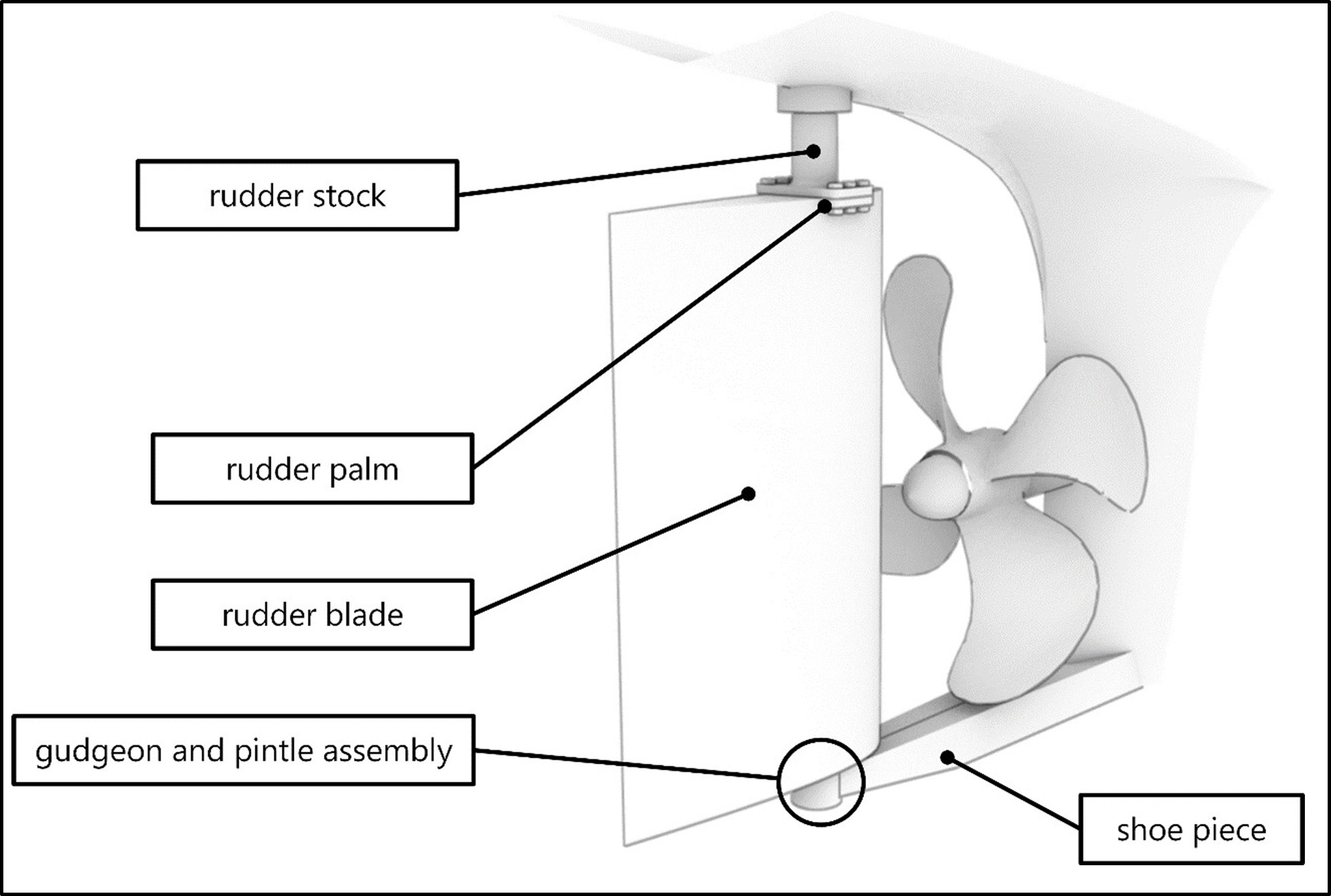
- The rudder stock was a single piece of forged SF440A carbon steel that included a horizontal flange piece (the rudder palm) at the bottom of the rudder stock. The rudder palm served as the connection point between the rudder stock and the rudder blade. The top of the rudder blade was secured to the rudder palm by six reamer bolts, three each on the port and starboard sides of the rudder stock.
- The bottom of the rudder blade was supported by a pintle that extended down from the bottom of the rudder into a gudgeon located at the end of the ship’s shoe piece.
- The rudder’s pintle served as a pivot point at the bottom of the rudder. The pintle was secured in the bottom of the rudder in a fixed position and extended downward into a bushing within the gudgeon (see Figure 4 and Figure 5). The bushing was water lubricated, enabling the pintle to rotate with the rudder without resistance.

- The gudgeon prevented the pintle and lower end of the rudder from having any transverse or fore and aft movements. A failure to prevent such movements results in excessive loads at the top of the rudder where it is secured to the rudder palm and stock.
Rudder pintle assembly
- According to the ship’s drawings, the pintle used on Achilles Bulker was a cylindrical pin made of carbon steel alloy SF440A weighing 428 kilograms (kg). The upper portion of the pintle was conical in shape, matching the tapered surface within the lower casting in the bottom of the rudder where the pintle was secured. When installed, the pintle was hydraulically pressed into the taper in the lower casting of the rudder, forming an interference fit. To operate correctly, the interference fit required 80% surface contact between the pintle and the tapered surface in the lower casting (see Figure 6).
- To maintain the interference fit, the top of the pintle was threaded and secured in the lower casting using a large washer and nut (see Figure 7).
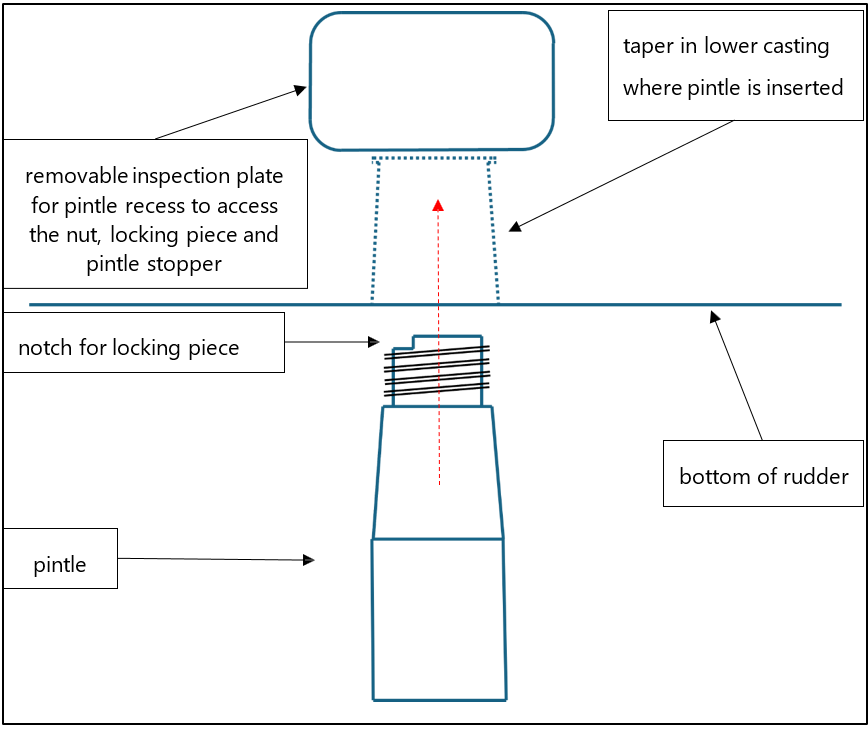
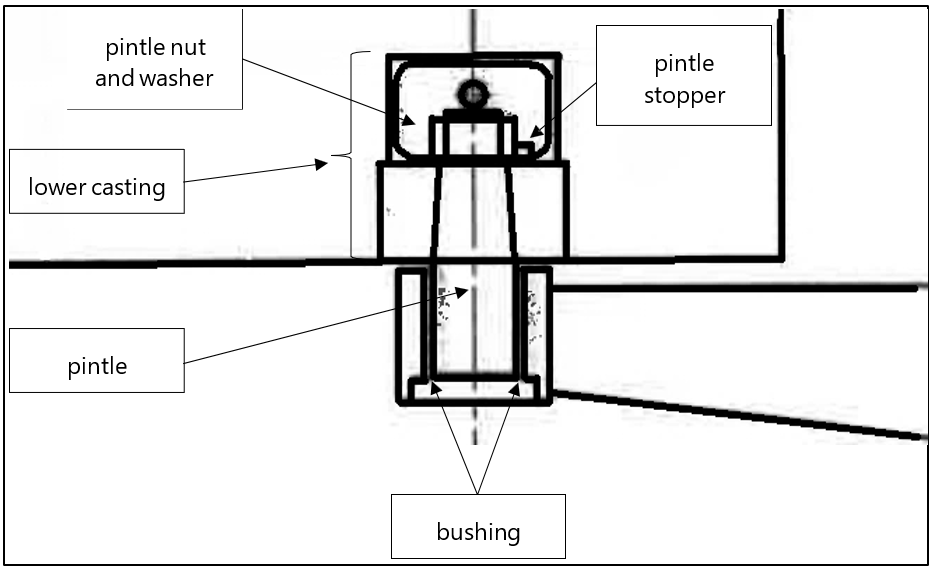
- A locking piece and pintle stopper were welded to the nut to prevent the pintle nut loosening. The pintle stopper was a piece of right-angle steel welded to the side of the pintle nut and the interior of the rudder. The locking piece was a steel bar that lay across the top of the pintle nut and sat inside a notch at the top of the pintle (see Figure 8). The locking piece was then welded in place.

Rudder maintenance
- During any dry dock period a class surveyor was required (IACS UR Z3.2.4- Visible parts of rudder, rudder pintles, rudder shafts and couplings and stern frame are to be examined. If considered necessary by the surveyor, the rudder is to be lifted or the inspection plates removed for the examination of pintles. The clearance in the rudder bearings is to be ascertained and recorded. Where applicable, pressure test of the rudder may be required as deemed necessary by the surveyor) to measure and record the clearances between the rudder’s pintle and bushing as part of their survey to monitor the bushing’s condition. Significant clearances (clearances greater than the allowable limit identified in the ship’s construction plan or manufacturer’s recommendation) between the pintle and bushing are to be avoided, as they allow for greater transverse and fore and aft movement of the lower part of the rudder. This, in turn, places excessive stress on the rudder palm and rudder stock.
- In September 2021 Achilles Bulker was dry docked (put in a basin that is flooded to allow the vessel to be floated in, then drained to allow the vessel to rest on a dry platform exposing the entire hull. Dry docks are used for construction, maintenance and repair) at Shanhaiguan Shipbuilding Industry Co Ltd (Shanhaiguan Shipyard) in China as part of a scheduled survey. During the survey, the class surveyor measured the clearances between the pintle and pintle bushing and found that they were close to exceeding the allowable limits. Consequently, the pintle bushing was replaced.
- To remove the pintle bushing, the pintle was removed from the bottom of the rudder. A hydraulic jack broke the pintle’s interference fit within the rudder’s lower casting, and the pintle was then lowered through the bushing.
- Once the bushing was replaced, the pintle was raised through the bushing and press-fitted into place in the bottom of the rudder with a hydraulic jack (see Figure 9 and Figure 10). This was the only time in the ship’s history that the pintle had been removed and reinstalled.


- According to Shanhaiguan Shipyard, the ship’s owners specified the repair work to be completed by the shipyard. The shipyard completed the work, which was covered by a repair warranty period of three months for movable parts and six months for fixed parts used in repair.
Wreckage examination and testing
- When the incident occurred, it was not immediately apparent to the ship’s crew that the rudder had been lost. However, a diver’s survey of the ship’s rudder and stern frame on 25 July 2023 immediately revealed that the rudder was missing and the casting for the rudder palm had fractured on both sides of the rudder stock (see Figure 11).
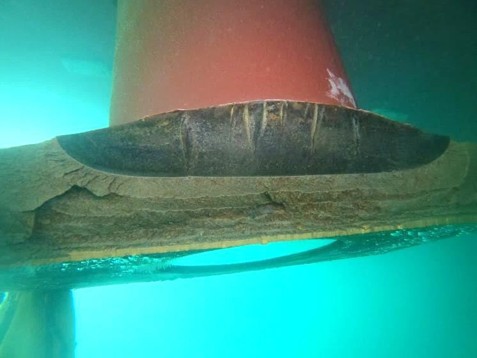
- Divers inspected the gudgeon and bushing and found no signs of significant damage. However, they did find that the cover plate – originally welded to the bottom of the gudgeon underneath the pintle – had broken away (see Figure 12).

- After an extensive search led by the Port of Tauranga, the rudder was recovered from the shipping channel on 26 July 2023 and taken ashore at the port.

- An inspection showed that the pintle was missing from the bottom of the rudder (see Figure 13). The pintle nut, locking piece and pintle stopper remained inside the pintle recess.
- Marine growth (including algae and barnacles) was found throughout the tapered surface of the lower casting. This finding (discussed further in paragraph 3.10) was of interest because the lower casting was normally watertight when the pintle was in position. Once dried out, the tapered surface was found to be corroded with developed pitting (see Figure 14).

- A metallurgist accompanied Commission investigators and examined the fractured surfaces of the rudder palm remnants (see Figure 15). They discovered that each fractured surface had an area of significant fatigue crack growth. This growth started at the top surface of the fractured palms on either side of the rudder stock, before working its way down into the palm.
- The fatigue cracking area consisted of smooth black zones that were stepped relative to each other. Each step represented a separate fatigue crack. Each crack started at the surface before continuing through the depth of the palm. The multiple fatigue cracks eventually merged into one single crack front. The remaining fracture surface showed clear signs of brittle overload.
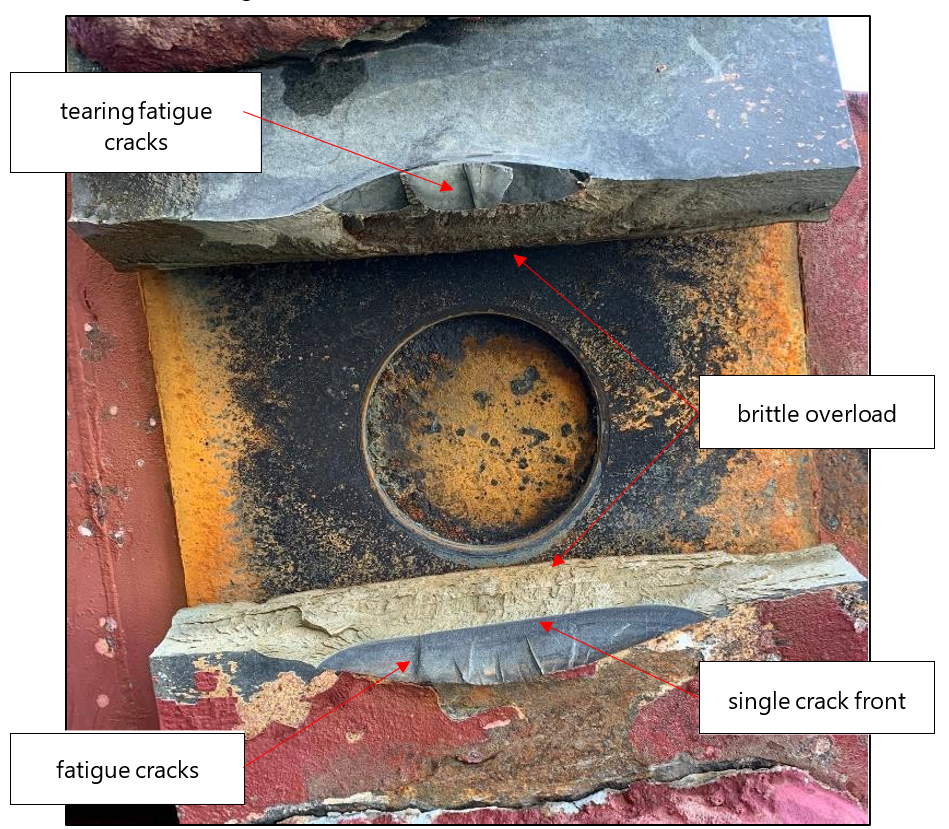
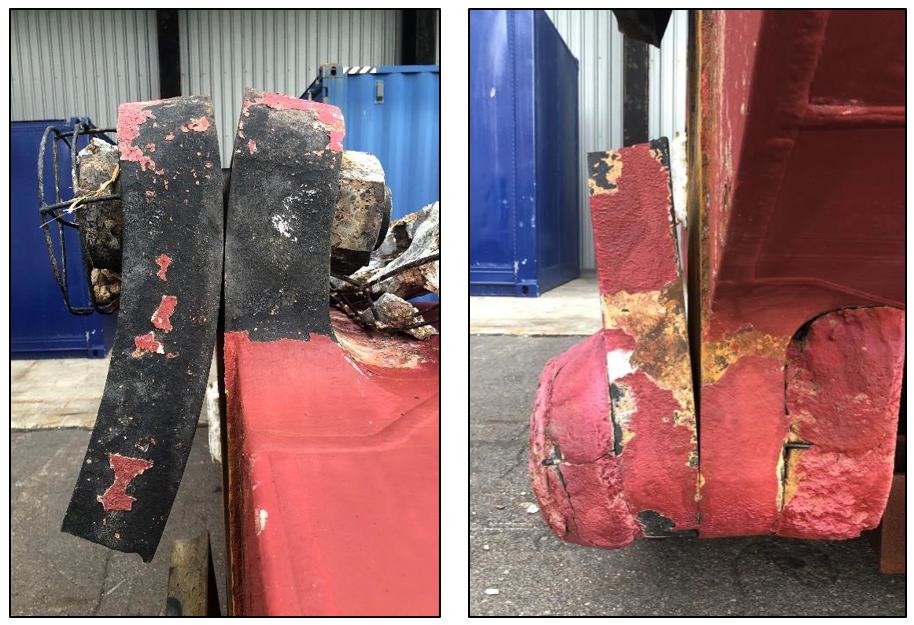
- The starboard side of the rudder palm showed a clean break with minimal bending. However, the port side of the rudder palm was significantly bent upwards with a tearing fatigue fracture (see Figure 16).

- The inspection plate of the pintle recess was then removed from the port side of the rudder (see Figure 17), enabling the removal of the remaining pintle components.
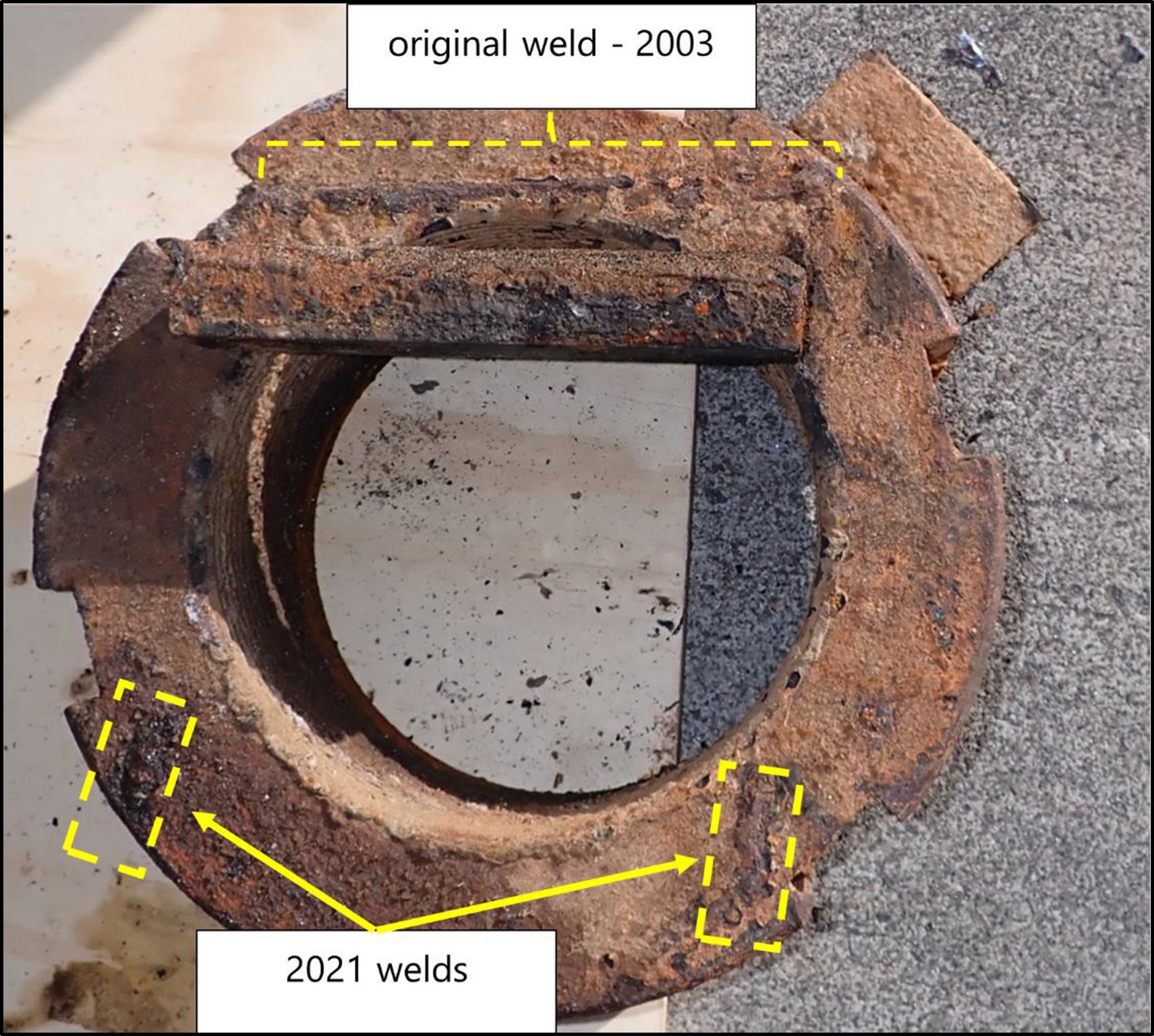
- An examination of the pintle nut revealed that the threads were intact and without any signs of damage. However, although undamaged, the threads were significantly corroded and covered with a thick layer of marine growth. The significance of this finding is discussed in more detail in paragraphs 3.15 and 3.16.
- Two sets of welds were identified on the pintle nut in relation to the installation of the pintle stopper and locking piece. One set was made when the ship was built in 2003 and the other was made in the 2021 dry dock period. Residual weld material found on the pintle stopper and locking piece related to the 2021 welds, which had limited weld penetration and were less substantial than the original 2003 welds (see Figure 18, Figure 19 and Figure 20).
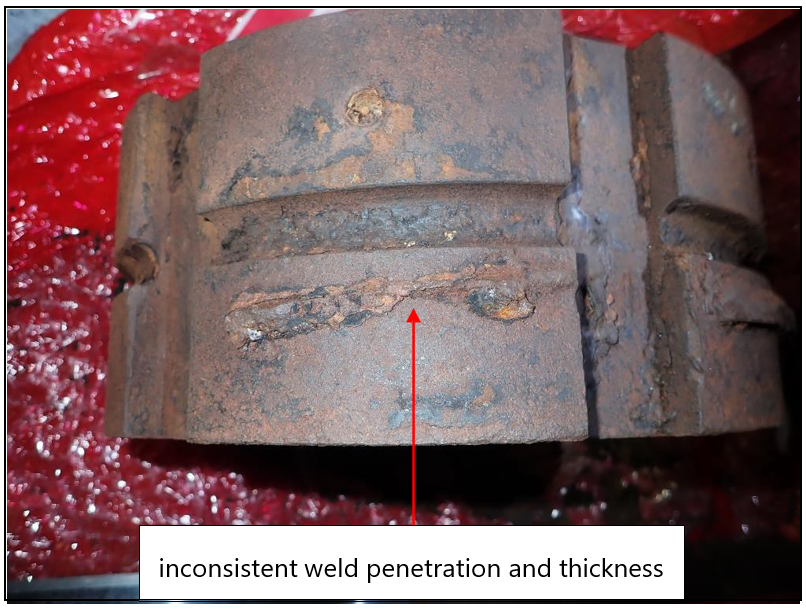
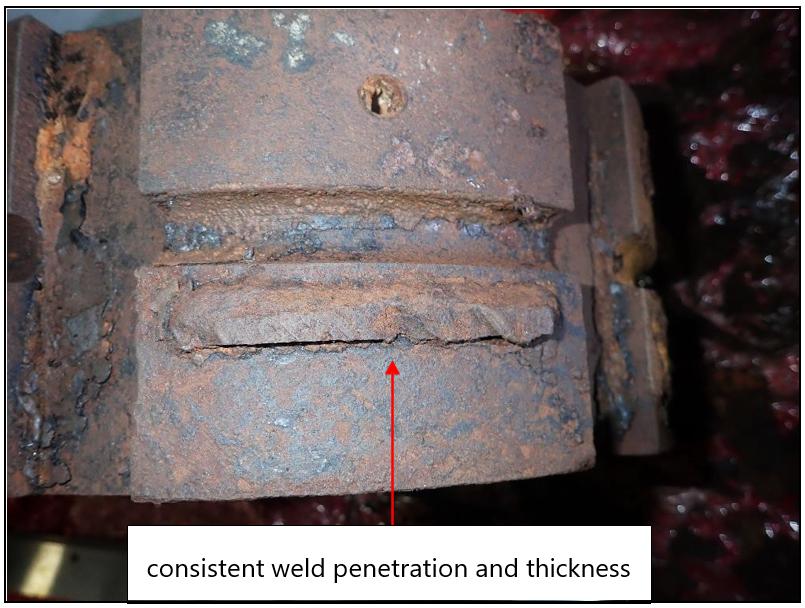
- Similarly, the weld securing the pintle stopper to the rudder blade had little penetration; gaps were visible between the two parts (see Figure 21 and Figure 22).
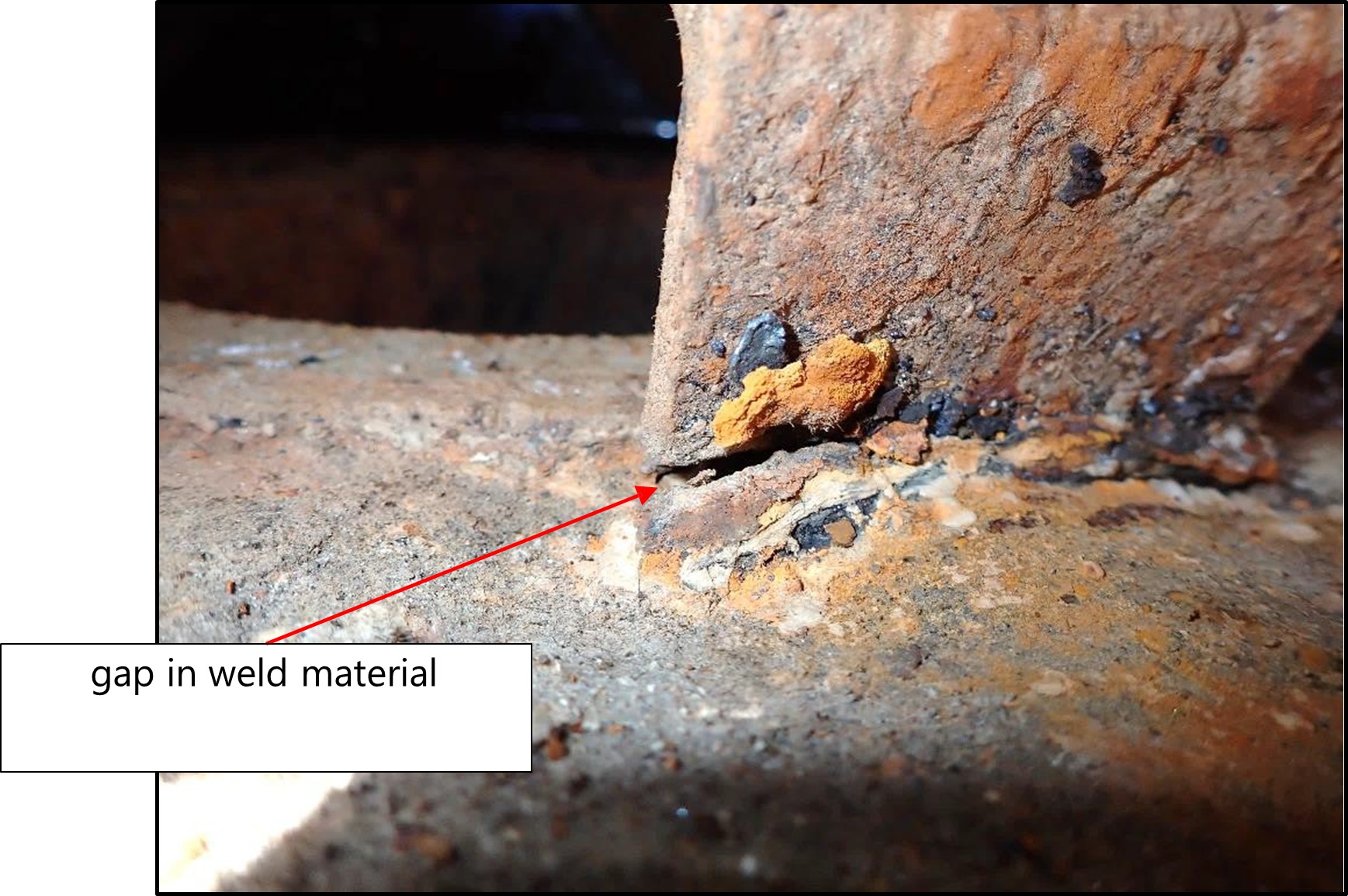
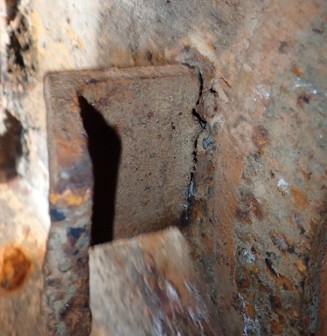
- Commission investigators oversaw metallurgical testing of the pintle nut, washer, locking piece and pintle stopper. This confirmed that the welds connecting the pintle stopper and locking piece to the nut had fractured. It was observed that all the weld material had significant porosity.
Previous similar occurrences
- Since 2003 the Commission has investigated and published reports (MO-2003-212 Container ship ‘Spirit of Enterprise’, touching bottom and loss of rudder, Manukau Bar, 16 August 2003; MO-2004-211 Coastal cargo vessel Southern Tiare, loss of rudder, off Mahia Peninsula, 4 July 2004; and MO-2013-203 DEV Aratere, fracture of starboard propeller shaft, resulting in loss of starboard propeller, Cook Strait, 5 November 2013) on three serious incidents that involved ships losing components of critical systems such as rudders and propellors. The safety themes described in these reports were:
- the development of fatigue cracks in components of critical systems
- inadequate welding practices contributing to the failure of critical systems
- inadequate documented procedures and a lack of oversight during critical installations.
- The reports called for:
- enhanced inspections checking for fatigue cracks in rudder stocks to be conducted by class surveyors and ship representatives
- raising awareness among class surveyors and ship representatives of the need to be vigilant when inspecting critical system welds during construction and subsequent surveys
- ship owners to ensure adequate oversight of major modifications, including appropriate documented procedures.
Analysis Tātaritanga
Introduction
- The Achilles Bulker lost its rudder when the rudder palm fractured on both sides of the rudder stock. When the rudder was recovered, the pintle was missing from the bottom of the rudder. The pintle was never found.
- The pintle bushing had been replaced in 2021 when the Achilles Bulker was in dry dock. This task necessitated the removal and reinstallation of the pintle. The job was not considered a regular task but one done to avoid damage to the rudder system.
- The following section analyses the circumstances surrounding the event to identify those factors which increased the likelihood of the event occurring or increased the severity of its outcome. It also examines any safety issues, which have the potential to adversely affect future operations.
Loss of rudder
- During the outbound passage, the ship’s heading began to swing to port, but the pilots were able to arrest the swing by applying hard starboard rudder with the engine full ahead. The qualified pilot then gave the command to ease the rudder from hard over to starboard 20, bringing the ship back towards the centre of the channel. During this manoeuvre the first loud bang was heard and the ship shuddered.
- Shortly after the bang the ship’s head started to swing to starboard, towards the centre of the channel. The qualified pilot ordered port rudder to counteract the swing. During this sequence the bridge team heard a second, more substantial, bang. It was immediately apparent that the ship was not responding appropriately to rudder commands. The qualified pilot directed the master to prepare the ship’s anchors as the ship continued its starboard swing out of the channel.
- It is virtually certain that the swift and well-coordinated actions of the pilots and ship’s crew prevented the ship running aground.
- An initial examination of Achilles Bulker found that the ship’s stern frame was structurally sound. There was no evidence of deformity or previous grounding that could have contributed to the loss of the rudder.
- However, with the pintle missing from the bottom of the rudder, excessive lateral loads would have been placed on the rudder palm and rudder stock during normal operations (see Figure 23).
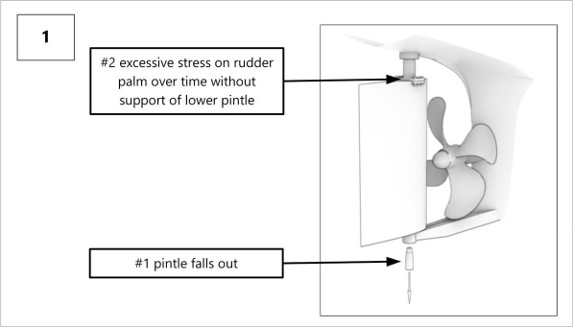
- Each fractured surface of the rudder palm had an area of significant fatigue crack growth that originated at the top surface of the fractured palms on either side of the rudder stock. That multiple initiation points developed into fatigue cracks was indicative of relatively high stress in that area. Likewise, the smooth, flat appearance of the cracks was indicative of slow growth over time with numerous load cycles. This suggested that the fatigue cracks had grown until the remaining material was unable to withstand the load, resulting in brittle overload. This type of crack development reflects a rudder palm and rudder stock being subjected to excessive lateral loads.
- Considering the development of marine growth (including algae and barnacles) on the tapered surface of the lower casting, and the accompanying developed fatigue cracks on the fractured rudder palms, the Commission determined that the pintle dropped out of position and was lost before the ship lost its rudder. As a result, excessive lateral loads had been placed on the rudder palm over time; these ongoing loads contributed to the development of fatigue cracks in the palm, reducing its overall strength.
- When the fractured rudder palm was examined, the starboard side palm showed a clean break with minimal bending, whereas the port side palm was significantly bent upwards.
- This, along with the sequence of rudder commands made by the pilots, showed that the starboard side of the rudder palm fractured first. Applying starboard rudder exposes the starboard side of the rudder blade to water pressure from the propeller wash. Without the transverse support of the pintle at the bottom of the rudder, excessive loads would have been placed on the starboard side of the rudder palm at the top of the rudder (see Figure 24).

- With the starboard palm fractured, the entire load of the rudder was placed on the port side of the palm, causing it to bend to the point of fracture.
- It is virtually certain that, because of overload, the fatigued palm fractured on both sides of the rudder stock while the pilots conducted standard ship-handling operations.
Loss of pintle
- The pintle nut was examined after the rudder was retrieved from the sea. The threads were intact without any signs of mechanical damage. However, the threads were corroded and covered with a thick layer of marine growth. For such growth and corrosion to take place without damage to the threads, it would require the nut to unwind from the top of the pintle and be submerged in seawater in the lower casting – an area intended to be watertight when the pintle is in place.
- When installed in the shipyard, the nut’s threads would have been coated in a thick lubricant that must have been removed by seawater for corrosion and marine growth to take place.
- It is virtually certain that the pintle nut unwound off the top of the pintle, allowing the pintle to drop out from the bottom of the rudder.
- The locking piece and pintle stopper are critical items that are welded to the pintle nut to ensure it does not loosen and unwind. On Achilles Bulker, the welds securing the locking piece and pintle stopper to the pintle nut had fractured. Those welds were susceptible to cracking from normal vibrations as they were generally poor quality with limited weld penetration.
- Without the support of the locking piece and pintle stopper, the pintle nut was susceptible to loosening and eventually unwinding from the pintle due to vibration and the general operation of the rudder.
- Additionally, the surface of the taper within the lower casting was found to be misshapen. It is unlikely that such a shape would have allowed for the necessary 80% surface contact between the pintle and the lower casting to be achieved, increasing the risk of the pintle experiencing excessive localised vibrations. Such vibrations would have increased the risk of welded components fracturing, with the potential to cause the pintle nut to unwind.
- The state of the welds securing the locking piece and pintle stopper to the pintle nut, along with the misshapen taper, suggests that the quality-assurance process used during the pintle installation was ineffective.
- Taking all available evidence into consideration, it is virtually certain that the way the rudder pintle assembly was installed did not ensure that the pintle would remain in place during normal shipboard operations.
Quality assurance of pintle installation
Safety issue: The installation and fitting of the rudder pintle assembly resulted in it failing, which exposed other components in the rudder system to excessive forces. This ultimately led to rudder loss and loss of control of the ship. A high level of quality assurance is required to ensure that a pintle and its associated components are installed effectively.
- Installation of a rudder pintle was typically overseen by representatives from the shipyard, the ship owner and classification society.
- Shanhaiguan Shipyard informed the Commission that the level of quality assurance conducted during pintle installation could vary depending on the specified requirements in the engineering sheet provided by the ship owner.
- Shanhaiguan Shipyard’s standard practice for removing and reinstalling a pintle was as follows:
- once a pintle was removed, the shipyard would clean the pintle, pintle nut and pintle sleeve
- the items were inspected for corrosion and measured for deformities
- the taper in the lower casting was cleaned and inspected
- the items were shown to a ship’s representative, then reinstalled if no corrosion or deformities were found.
- An engineering sheet provided by a ship operator could include ship-specific requirements for additional testing. For example, measuring the taper in the lower casting and/or conducting a blue fit test to ensure the pintle has achieved the required 80% surface contact with the taper. However, if such requirements were not actively specified, the shipyard would default to the standard process, which does not confirm that the taper was of the appropriate shape or that the pintle had made proper surface contact when installed. Aside from specific direction from the ship operator, a blue fit test for the pintle was typically only done when a ship was being built and after a major rudder repair, if appropriate.
- The removal of a pintle to replace the bushing was considered by classification societies to be routine maintenance and not a major rudder repair.
- The Commission engaged an independent expert, who confirmed that the standard practice provided by Shanhaiguan Shipyard for the removal and reinstallation of the pintle was considered normal practice for shipyards around the world.
- Detailed procedures for the appropriate removal and installation of the pintle can be found in rudder system installation procedures, which shipbuilders commonly provide to ship owners for maintenance purposes.
- The provision of a rudder system installation procedure is not mandated by the International Association of Classification Societies (IACS), the International Maritime Organization (IMO) or the International Convention for the Safety of Life at Sea (SOLAS). However, it is implied that such procedures would be required by shipyards and ship owners during dry docking.
- According to IMO MSC.1/Circ.1135 (International Maritime Organization, 15 December 2004) and SOLAS (SOLAS Chapter II-1, Part A-1, Regulation 3-7– Construction drawings maintained on board and onshore), as-built drawings must be kept on board and ashore for ships constructed on or after 1 January 2007, to facilitate the proper planning and conduct of surveys, repairs and owners’ inspections. Although Achilles Bulker was built in 2003, the ship did have drawings. However, they did not include the technical procedures necessary for the installation of the rudder pintle assembly.
- In the absence of a specific rudder-installation procedure, the dry docking shipyard must have the necessary expertise and capability to perform rudder-system repairs and renewals. Most shipyards have established procedures for carrying out such projects, as they are common in nature, with specific information such as materials, bearing clearance, dimensions, push-up length and pressure (as would be provided in as-built plans).
- The Commission requested both the shipyard and the ship owner to provide the procedures and engineering sheet used for the removal and installation of the rudder pintle on Achilles Bulker. Neither has provided such documentation.
- Classification societies are required to examine visible parts of the rudder system and measure the clearances between a pintle and its associated bushing during each dry dock as per IACS UR Z3 (Unified Requirements (URs) are minimum standards adopted by IACS to ensure consistency and enhance safety and environmental protection in the shipping industry). Out-of-water bottom survey. IACS UR Z3 did not include a requirement for classification societies to verify the fitting of the pintle in the lower casting nor the adequacy of the locking arrangements after reinstallation. As such, the information provided in the survey report was limited to the measured clearances between the bushing and pintle before and after reinstallation.
- Ships in the global fleet have a variety of rudder types and pintle arrangements. The level of risk associated with pintle installation varies depending on the pintle arrangement. If a pintle is installed incorrectly it will, at a minimum, damage the rudder system through excessive wear and vibration.
- Ships with a similar pintle arrangement to Achilles Bulker are at far greater risk, as the pintle can drop out and lead to eventual rudder loss, putting seafarers and the environment in significant danger. It is for this reason that greater oversight and quality assurance during the installation of pintles and their securing components is needed. The Commission has made recommendations in Section 6 of this report to address this safety issue.
Findings Ngā kitenga
- The initial examination of Achilles Bulker found that the ship’s stern frame was structurally sound. There was no evidence of deformity or previous grounding that could have contributed to the loss of the rudder.
- The welds securing the locking piece and pintle stopper to the pintle nut had fractured. Those welds were susceptible to cracking from normal vibrations as they were generally poor quality with limited weld penetration.
- The surface of the taper within the lower casting was found to be misshapen. It is unlikely that such a shape would have allowed for the necessary 80% surface contact between the pintle and lower casting to be achieved, increasing the risk of the pintle experiencing excessive localised vibrations.
- It is virtually certain that the pintle nut unwound off the top of the pintle, allowing the pintle to drop out from the bottom of the rudder.
- The pintle dropped out of position and was lost before the ship lost its rudder. As a result, excessive lateral loads had been placed on the rudder palm over time; these ongoing loads contributed to the development of fatigue cracks in the palm, reducing its overall strength.
- It is virtually certain that, because of overload, the fatigued palm fractured on both sides of the rudder stock while pilots conducted standard ship-handling operations.
- It is virtually certain that the way the rudder pintle assembly was installed did not ensure that the pintle would remain in place during normal shipboard operations.
- It is virtually certain that the swift and well-coordinated actions of the pilots and ship’s crew prevented the ship running aground.
Safety issues and remedial action Ngā take haumaru me ngā mahi whakatika
General
- Safety issues are an output from the Commission’s analysis. They may not always relate to factors directly contributing to the accident or incident. They typically describe a system problem that has the potential to adversely affect future transport safety.
- Safety issues may be addressed by safety actions taken by a participant. Otherwise the Commission may issue recommendations to address the issues.
- One safety issue was identified in this investigation.
Safety issue: The installation and fitting of the rudder pintle assembly resulted in it failing, which exposed other components in the rudder system to excessive forces. This ultimately led to rudder loss and loss of control of the ship. A high level of quality assurance is required to ensure that a pintle and its associated components are installed effectively.
- No action has been taken to address this safety issue. Therefore the Commission has made a recommendation in Section 6 of this report to address this issue.
Recommendations Ngā tūtohutanga
General
- The Commission issues recommendations to address safety issues found in its investigations. Recommendations may be addressed to organisations or people, and can relate to safety issues found within an organisation or within the wider transport system that have the potential to contribute to future transport accidents and incidents.
- In the interests of transport safety, it is important that recommendations are implemented without delay to help prevent similar accidents or incidents occurring in the future.
New recommendations
- On 26 June 2025, the Commission recommended that Shanhaiguan Shipbuilding Industry Co Ltd implement quality assurance practices to ensure all rudder pintle assemblies are effectively installed. [043/25]
- On 26 June 2025, the Commission recommended that Maritime New Zealand investigate and submit papers as appropriate to the IMO (through the appropriate sub-committee) to promote standards that ensure sufficient quality assurance for rudder systems throughout the process of installation, alterations, major repairs and maintenance. [044/25]
-
On 17 July 2025, Maritime New Zealand replied:
Maritime NZ partially accepts this recommendation
The Achilles Bulker incident on its own is unlikely to present a compelling case for work at an international body. Maritime NZ, in collaboration with MAIF (through the relationship with TAIC) will investigate, building an evidential base for action to improve quality assurance systems related to dry dock work, which would include installation, major repairs and maintenance of ship systems.
The information gathered will allow Maritime NZ to determine the most appropriate avenue within the IMO and other international forums or associations, to promote standards that ensure sufficient quality assurance. There are a number of international forums / associations and potential work pathways that may be more suitable for this purpose.
MNZ acknowledges the work TAIC has undertaken in this matter and we welcome the insights gained.
Notice of recommendations
- The Commission gives notice to the Maritime Safety Administration of the People’s Republic of China that it has issued recommendation [043/25] to Shanhaiguan Shipbuilding Industry Co Ltd.
Key lessons Ngā akoranga matua
- Pintle assemblies are critical components of a critical system and should be treated as such. The way the rudder pintle assembly is installed is important for the durability of the rudder system and to prevent losing the pintle and rudder.
- Ship owners and operators have overall responsibility for the ship. Therefore, it is important that they have sufficient oversight of repairs to components of critical systems to ensure the repairs are effective.
- The loss of controlled manoeuvrability of a ship is particularly dangerous when navigating in pilotage waters. Pilots and ship crews need to be prepared for such an event.
Vehicle particulars Whakarāpopoto raraunga
Details
Conduct of the inquiry Te whakahaere i te pakirehua
- On 25 July 2023, Maritime New Zealand notified the Commission of the occurrence. The Commission subsequently opened an inquiry under section 13(1) of the Transport Accident Investigation Commission Act 1990 and appointed an Investigator-in-Charge.
- In accordance with section 14(3) of the Transport Accident Investigation Commission Act 1990, the Chief Investigator of Accidents consented to Maritime New Zealand boarding the vessel to conduct its own investigation of the incident.
- On 26 July 2023, the Commission issued a Protection Order under section 12 of the Transport Accident Investigation Commission Act 1990. The Order related to the vessel’s steering-gear system and associated equipment involved in the incident and was issued to preserve and protect any evidence that was present.
- In accordance with the IMO casualty code, the Commission notified the vessel’s flag state49 (Panama) of the incident and invited its participation in the Commission’s inquiry.
- On 28 July 2023, two Commission investigators accompanied by a metallurgist travelled to the Port of Tauranga to examine the rudder and interview witnesses.
- On 8 August 2023, three Commission investigators travelled to the Port of Tauranga to interview crew members and collect evidence. The pintle nut, pintle stopper, locking piece and washer were seized and transported to a secure facility in Wellington.
- On 31 October 2023, the Commission removed and seized the two fractured rudder palm remnants and transported them to a secure facility in Wellington.
- On 23 May 2024, the Commission engaged an independent expert on rudder installation and maintenance through the Institute of Marine Engineering, Science and Technology.
- Between 24 and 27 June 2024, the pintle nut, pintle washer, locking piece and pintle stopper underwent partially destructive metallurgical testing at a facility in Auckland. Representatives from the Commission, the ship owner, the charterer and the cargo owner were present. The items were then repacked and returned to the Commission’s facility in Wellington.
- On 12 December 2024, the Commission approved a draft report for circulation to eight interested parties for their comment.
- On 26 February 2025, the Commission approved a revised draft report for circulation to eight interested parties for their comment and two independent experts to ensure accuracy of the report.
- Four interested parties provided a detailed submission, and two interested parties replied that they had no comment. Two interested parties did not respond despite efforts to contact them. One independent expert provided a detailed submission and one independent expert replied that they had no comment. Any changes as a result of the submissions have been included in the final report.
- On 26 June 2025, the Commission approved the final report for publication.
Glossary Kuputaka
- Bushing
- A cylindrical sleeve that facilitates rotational movement between two parts.
- Dry dock
- A basin that can be flooded to allow a vessel to be floated into it, then drained, to allow the vessel to rest on a dry platform exposing the entire hull. Dry docks are used for vessel construction, maintenance and repair
- Escort tug
- A tug that follows a ship to assist in manoeuvrability if required.
- Fore and aft movement
- A longitudinal movement towards the bow and stern
- Heading (marine)
- The compass direction in which a vessel’s bow is pointing.
- Pilot
- A role defined in the operator’s Operations Manual as being responsible for daily management of pilots and ground crew and can task a pilot for flying duties.
- Pilotage waters
- Navigable waters in which a ship is usually required to use the services of a maritime pilot
- Port
- The side of a vessel that is left when facing forward
- Starboard
- The right side of a vessel when the viewer is facing forward
Citations Ngā tohutoru
International Association of Classification Societies. (8 Apr 2019). Unified Requirements UR Z3 Periodical survey of the outside of the ship’s bottom and related items. Retrieved from https://iacs.org.uk/resolutions/unified-requirements/ur-z
International Maritime Organization. (15 December 2004). MSC/Circular.1135 – As-Built Construction Drawings to be Maintained on Board the Ship and Ashore.
Transport Accident Investigation Commission. (2004). MO-2003-212 Container ship ‘Spirit of Enterprise’, touching bottom and loss of rudder, Manukau Bar, 16 August 2003.
Retrieved from https://www.taic.org.nz/inquiry/mo-2003-212
Transport Accident Investigation Commission. (2005). MO-2004-211 Coastal cargo vessel Southern Tiare, loss of rudder, off Mahia Peninsula, 4 July 2004. Retrieved from https://www.taic.org.nz/inquiry/mo-2004-211
Transport Accident Investigation Commission. (2016). MO-2013-203 DEV Aratere, fracture of starboard propeller shaft, resulting in loss of starboard propeller, Cook Strait,
5 November 2013. Retrieved from https://www.taic.org.nz/inquiry/mo-2013-203
Document downloads
Related Recommendations
On 26 June 2025, the Commission recommended that Shanhaiguan Shipbuilding Industry Co Ltd implement quality assurance practices to ensure all rudder pintle assemblies are effectively installed.
On 26 June 2025, the Commission recommended that Maritime New Zealand investigate and submit papers as appropriate to the IMO (through the appropriate sub-committee) to promote standards that ensure sufficient quality assurance for rudder systems throughout the process of installation, alterations, major repairs and maintenance.
